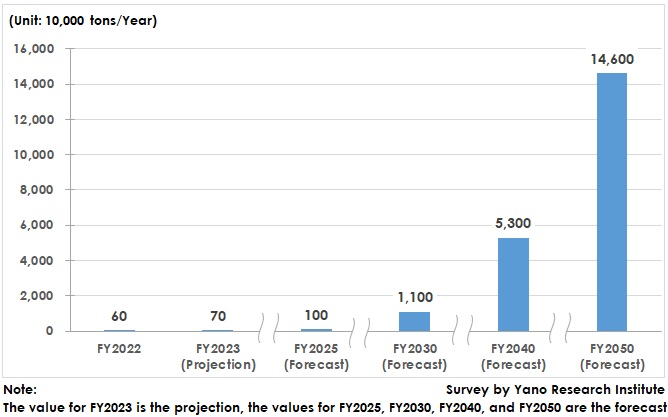No.3539
CCUS (Carbon Capture, Utilization, and Storage) Technologies in Japan: Key Research Findings 2024
CO2 Collections via CCUS Technologies Forecasted at 146 Million Tons by FY2050 in Japan
Yano Research Institute (the President, Takashi Mizukoshi) has surveyed the domestic carbon capture, utilization, and storage) market, and found out the trends in technologies, trends of market players, and future perspectives. Here highlights the forecast of domestic CO2 capture by means of CCUS technologies.

Market Overview
The Paris Agreement, that entered into force in 2016, sets a common long-term goal to keep limiting the rise of global average temperature at below 2 degrees Celsius, preferably below 1.5 degrees Celsius, when compared to pre-industrial levels. In Japan, the 2050 Carbon Neutral Declaration has accelerated the movement toward reducing greenhouse gas (GHG) emissions represented by carbon dioxide (CO2).
Nevertheless, as rapid transition to renewables is difficult in terms of stable energy supply, an immediate challenge is to reduce CO2 emissions from thermal power generation that is regarded as a regulated power supply. Other high CO2 spewing facilities such as iron mills, cement plants, garbage incineration facilities, etc. have the similar issue. To address this, the technological development and verification projects for CCUS (Carbon Capture, Utilization, and Storage) technologies are underway.
CO2 collections by means of CCUS technologies for FY2022 in Japan is estimated at annual 600 thousand tons, which equivalents to the volume of CO2 emitted by about 220 thousand households (0.4% of the total domestic number of households as of Jan. 2023), as the Ministry of Environment has estimated CO2 emissions per household at 2.74 tons per year for FY2021.
Separation and capture of CO2 are the necessary processes in common for effective usage and storage of CO2, and there are following methods: chemical absorption, physical absorption, use of solid sorbents, and membrane separation. The candidate destinations of CO2 isolated and collected are storage to underground stratum and reuse as resources. Currently demonstrations and practical applications are underway for social implementation of CCS (carbon capture and storage) technologies and carbon recycling technologies that utilize CO2 after converting it into other substances.
Noteworthy Topics
Trend of CCS Projects in Japan
The Agency of Natural Resources and Energy of Ministry of Economy, Trade and Industry (METI) released its CCS Long-Term Roadmap in March 2023, which aims to boost deployment of carbon capture and storage (CCS) technologies by preparing conducive CCS business environment by 2030.
To achieve this, the roadmap has shown six concrete actions, i.e., CCS business support by the government, efforts on CCS cost reductions, improving public understanding to CCS business, enhancing overseas CCS promotions, putting in place necessary legislation (CCS Business Act), and forming and reviewing of CCS Action Plan.
In June 2023 Japan Organization for Metals and Energy Security (JOGMEC) has chosen seven role model projects named as Japanese Advanced CCS Projects to provide support to the entire CCS value chain from CO2 separation, capture to transport and storage. These projects have been participated by companies from various industries including power generation, oil refinery, steel, chemical, pulp/paper, and cement, and have commenced initiatives by utilizing technologies and knowledge cultivated in existing projects and demonstrations, etc. for each area of CO2 separation, capture, transport, or storage.
As can see from the Cabinet approval on the bill for the Act on Carbon Storage Businesses (CCS Business Act) In Februaty 2024, preparations for full-scale CCS project implementation are underway.
Future Outlook
CO2 collections by means of CCUS technologies in Japan expect to reach 11 million tons per year by FY2030, and 146 million tons per year by FY2050. The CO2 capture for FY2050 equivalents to 15% of 1,037 million tons per year, the domestic CO2 emissions for FY2022.
For storage area of CCUS technologies, the seven projects on storage, that has been selected as the Advanced CCS Projects, plan to commence business by 2030, targeting total 130 million tons of CO2 storage a year. The progress of the concerned business is likely to increase CO2 capture in the country exponentially. As CCS Long-Term Roadmap targets annual 120 to 240 million tons of CO2 storage by 2050, CO2 collections are projected to increase in Japan by realizing the above-mentioned six concrete actions.
On the other hand, many of carbon recycling technologies aiming to effectively use CO2 are still in the development phase, though some are already in practical applications, and those in practical applications have the issue to reduce costs. The full implementation of carbon recycling technologies in society is expected to start gradually from around 2030.
Research Outline
2.Research Object: R&D institutions studying CCUS technologies and businesses offering the technologies (engineering manufacturers, material manufacturers, cement manufacturers, power generation businesses, gas companies, oil & natural gas developers), funds, etc.
3.Research Methogology: Face-to-face interviews (including online) by expert researchers, and literature research
CCUS Technologies
CCUS (Carbon Capture, Utilization, and Storage) technologies are the methods to isolate and capture CO2 from gas emitted by thermal power plants or factories to effectively make use of it as a sort of resources for crop production and manufacturing chemical products, or to store it within stable underground stratum.
<Products and Services in the Market>
Technologies for separating and capturing CO2, Technologies for efficient use of CO2, Technologies for storing CO2
Published Report
Contact Us
The copyright and all other rights pertaining to this report belong to Yano Research Institute.
Please contact our PR team when quoting the report contents for the purpose other than media coverage.
Depending on the purpose of using our report, we may ask you to present your sentences for confirmation beforehand.